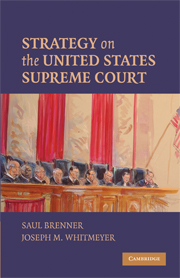Book contents
- Frontmatter
- Contents
- Preface
- PART I INTRODUCTION
- PART II CERTIORARI
- PART III THE CONFERENCE VOTE ON THE MERITS
- PART IV THE MAJORITY OPINION AND OTHER OPINIONS
- PART V THE FINAL VOTE ON THE MERITS
- 12 The Separation of Powers Model
- 13 Supreme Court Decision Making and Public Opinion
- PART VI CONCLUDING CHAPTERS
- Appendix 1 Decision Making on the United States Supreme Court
- Appendix 2 Additional Questions to Explore
- References
- Table of Cases
- Index
12 - The Separation of Powers Model
Published online by Cambridge University Press: 05 June 2012
- Frontmatter
- Contents
- Preface
- PART I INTRODUCTION
- PART II CERTIORARI
- PART III THE CONFERENCE VOTE ON THE MERITS
- PART IV THE MAJORITY OPINION AND OTHER OPINIONS
- PART V THE FINAL VOTE ON THE MERITS
- 12 The Separation of Powers Model
- 13 Supreme Court Decision Making and Public Opinion
- PART VI CONCLUDING CHAPTERS
- Appendix 1 Decision Making on the United States Supreme Court
- Appendix 2 Additional Questions to Explore
- References
- Table of Cases
- Index
Summary
In Chapters 5 through 11 we investigated intracourt strategies, in other words, strategies that a justice might pursue in light of how his colleagues on the Court were likely to behave. In this chapter and in Chapter 13 we will explore strategies that a justice might follow based on how outside audiences are likely to behave.
One of the Supreme Court's most important jobs is the interpretation of federal statutes. At times, it decides whether a federal statute is unconstitutional or not. More often, it merely decides what a statute means. In other words, we can distinguish between the Court's constitutional decisions and its statutory decisions. When the Court hands down a statutory decision, Congress, in turn, can enact an overriding statute. In response, the Court may have the opportunity of interpreting the new statute. The process, of course, can go on indefinitely, with neither institution having the last licks.
The separation of powers (SOP) model mainly focuses on the statutory decisions of the Court. Baum (2007, p. 147) describes this model:
… justices might try to calculate whether their preferred interpretation of a statute would be sufficiently unpopular in Congress to produce an override. If so, justices would modify their interpretations to avoid that result. By making implicit this compromise with Congress, the justices could get the best possible result under the circumstances: not the interpretation of a statute that they favor most, but one that is closer to their preferences than the new statute that Congress would enact to override the Court's decision.
- Type
- Chapter
- Information
- Strategy on the United States Supreme Court , pp. 115 - 126Publisher: Cambridge University PressPrint publication year: 2009

